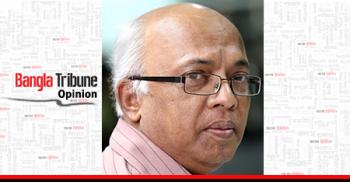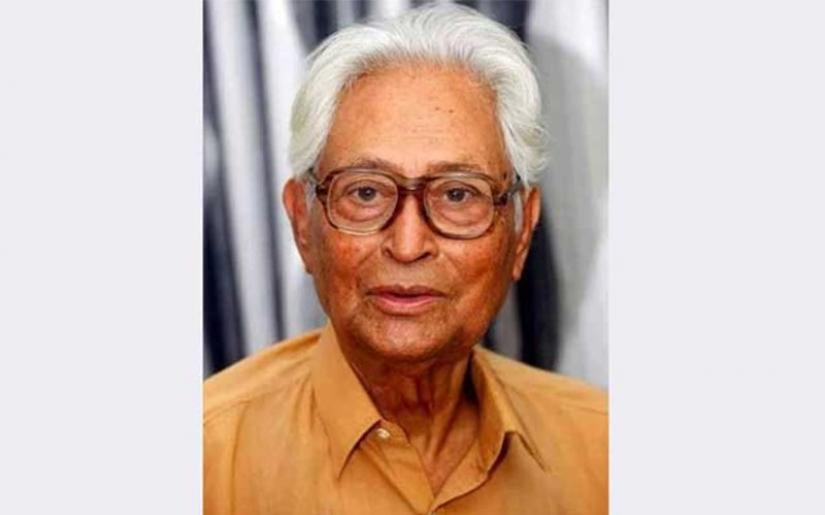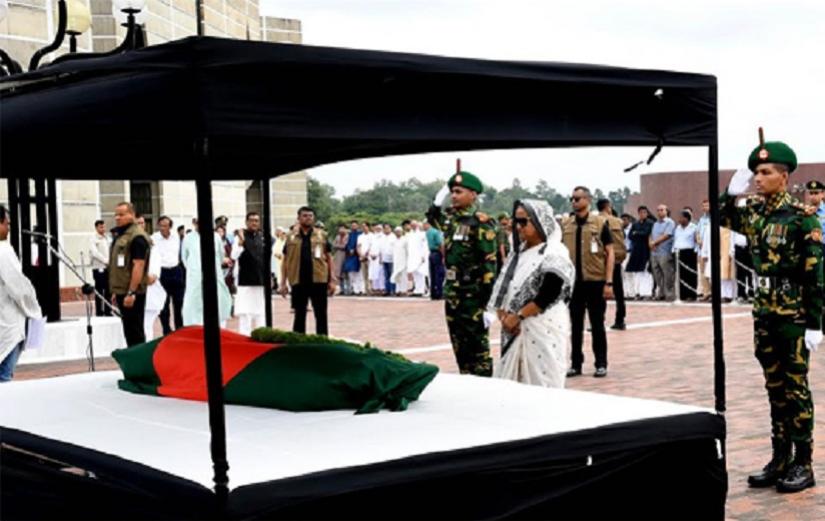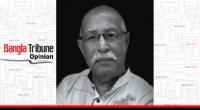 At the Round Table Conference convened by the tottering regime of Field Marshal Mohammad Ayub Khan in Rawalpindi in February 1969, Nawabzada Nasrullah Khan, spokesman for the opposition at the talks, began his address in Urdu. Professor Muzaffar Ahmed swiftly raised his objection. Urdu, he made it clear, was not the language of the Bengalis represented at the RTC. Neither was it the language of the four other provinces constituting West Pakistan. The point was taken. The proceedings of the conference then commenced in English and stayed that way for its entire duration.
At the Round Table Conference convened by the tottering regime of Field Marshal Mohammad Ayub Khan in Rawalpindi in February 1969, Nawabzada Nasrullah Khan, spokesman for the opposition at the talks, began his address in Urdu. Professor Muzaffar Ahmed swiftly raised his objection. Urdu, he made it clear, was not the language of the Bengalis represented at the RTC. Neither was it the language of the four other provinces constituting West Pakistan. The point was taken. The proceedings of the conference then commenced in English and stayed that way for its entire duration.
That was a sign of Muzaffar Ahmed’s conviction, in that year of democratic awakening, of the Bengali right to political assertion. He was part of the National Awami Party headed by Khan Abdul Wali Khan, son of the redoubtable Khan Abdul Ghaffar Khan and nephew of the late Khan Sahib, the prominent political leader of the North-West Frontier Province, today’s Khyber-Pakhtunkhwa. There was of course the other National Awami Party headed by Moulana Abdul Hamid Khan Bhashani. Together the two factions of the NAP (the original NAP led by Bhashani had split in 1967, ten years after it was founded in 1957) made quite an impression on Pakistan’s politics at the time. Muzaffar Ahmed and Wali Khan were regarded, and quite rightly too, as pro-Moscow in their understanding and acceptance of socialism as a national goal to be attained for the entirety of Pakistan.
Now that Prof. Muzaffar Ahmed has gone the way of all flesh, it would be well to remember the signal contributions he made to national history through the 1960s and then during the War of Liberation in 1971. As a significant member of the political advisory group to the Mujibnagar government, Muzaffar Ahmed was instrumental in the formulation of plans and proffering of suggestions geared to transforming the guerrilla struggle into an all-encompassing armed movement for freedom rather than allowing it to be confined within the parameters of the much larger and therefore considerably more influential Awami League. He shared pride of place in the group with Bhashani and the Communist Party leader Moni Singh. It was the nation’s good fortune that the advisory group, an idea emanating from Prime Minister Tajuddin Ahmad, was able to offer thoughts and suggest strategies that would intensify the struggle against Pakistan and bring about the totality of change the nation looked forward to. The change would be the defeat of Pakistan’s forces and the rise of Bangladesh. Muzaffar Ahmed’s politics immediately after the country’s liberation was certainly of an encouraging sort. With the Awami League having become unassailable owing to the dominant role it had played in an articulation of the national interest and guiding the country to freedom, it became necessary nevertheless for a political opposition to shape up in the new liberal and secular dispensation that was Bangladesh. Muzaffar’s NAP, with its unwavering belief in constitutional politics, appeared well-placed to clothe itself in the raiment of opposition, despite there being little chance of its slicing into the popularity of the Awami League headed by Bangabandhu Sheikh Mujibur Rahman. And yet Prof. Muzaffar Ahmed was acutely aware of what he needed to do at that point of time. He had his party take part, with the thatched hut as its symbol, in the general elections held in sovereign Bangladesh in March 1973. The result of the effort was dismal. The NAP could make no dent in the wall of support the Awami League enjoyed in the country. But that it did go into challenging the hegemony of the Awami League was the conveying of a hope: over a period of time, Muzaffar’s party could contribute to the making of a vibrant two-party system in the country.
Muzaffar Ahmed’s politics immediately after the country’s liberation was certainly of an encouraging sort. With the Awami League having become unassailable owing to the dominant role it had played in an articulation of the national interest and guiding the country to freedom, it became necessary nevertheless for a political opposition to shape up in the new liberal and secular dispensation that was Bangladesh. Muzaffar’s NAP, with its unwavering belief in constitutional politics, appeared well-placed to clothe itself in the raiment of opposition, despite there being little chance of its slicing into the popularity of the Awami League headed by Bangabandhu Sheikh Mujibur Rahman. And yet Prof. Muzaffar Ahmed was acutely aware of what he needed to do at that point of time. He had his party take part, with the thatched hut as its symbol, in the general elections held in sovereign Bangladesh in March 1973. The result of the effort was dismal. The NAP could make no dent in the wall of support the Awami League enjoyed in the country. But that it did go into challenging the hegemony of the Awami League was the conveying of a hope: over a period of time, Muzaffar’s party could contribute to the making of a vibrant two-party system in the country.
That hope turned out to have been misplaced. The NAP, together with the CPB, went for a political alliance with the AL. That left the space for opposition politics open, with the disturbing reality of the newly formed but politically impetuous Jatiya Samajtantrik Dal soon coming to occupy that space in incompetent fashion. The NAP, again with the CPB, was instrumental in encouraging the passage of the Fourth Amendment to the Constitution in early 1975, thereby paving the path for the rise of the Bangladesh Krishak Sramik Awami League (Baksal). The NAP gave no sign that it was uncomfortable with the changes brought about in the national political landscape. The party’s enthusiastic readiness to be part of Baksal in a crucial way led to a downgrading of its political standing in the country. It was not to recover the eminence it enjoyed before throwing in its lot with the AL in the planning and implementation of the Baksal project. In the chaotic period following the assassinations of Bangabandhu and the four national leaders, with the Awami League stymied by the repressive policies of the unconstitutional military regimes commandeering the country, the NAP failed to come forward in defence of a restoration of democracy. It withdrew into itself. At a time when the political rightwing, inclusive of the 1971 collaborators rehabilitated by the Zia regime, was having a field day subverting the secular ethos of the nation, the NAP, like other liberal, non-communal organizations, was unable to rise to the occasion. It remains a tragedy for the country that while medieval politics promoted by the regime and bringing together parties which had violently opposed Bangladesh’s freedom struggle in 1971 seized increasingly larger swaths of territory, the NAP was unable to make itself heard. The AL, deeply entrenched as a political force, was soon to be on its way back into the centre of politics. The NAP began to turn stagnant.
In the chaotic period following the assassinations of Bangabandhu and the four national leaders, with the Awami League stymied by the repressive policies of the unconstitutional military regimes commandeering the country, the NAP failed to come forward in defence of a restoration of democracy. It withdrew into itself. At a time when the political rightwing, inclusive of the 1971 collaborators rehabilitated by the Zia regime, was having a field day subverting the secular ethos of the nation, the NAP, like other liberal, non-communal organizations, was unable to rise to the occasion. It remains a tragedy for the country that while medieval politics promoted by the regime and bringing together parties which had violently opposed Bangladesh’s freedom struggle in 1971 seized increasingly larger swaths of territory, the NAP was unable to make itself heard. The AL, deeply entrenched as a political force, was soon to be on its way back into the centre of politics. The NAP began to turn stagnant.
The decline of the National Awami Party was precipitated, again, by the inability of its leadership and more specifically of Professor Muzaffar Ahmed to foster a system of succession at the top. The reluctance of the party chief to part with authority and in effect stay away from taking measures to have a second tier of leadership grow within the party proved to be a formidable barrier to the rejuvenation the NAP was in need of if it meant to make itself relevant again in national politics. Prof. Muzaffar Ahmed’s hold on the party, with little or no inclination to reinvent it organizationally or hand over authority to a new generation of leaders, only speeded up the decline of the NAP. It followed, eerily, in the footsteps of the NAP led by Bhashani and the Jatiyo Janata Party headed by M.A.G. Osmany. The dominant, indeed domineering leadership of the two men led, predictably, to the demise of their parties once they had succumbed to mortality.
The death of Prof. Muzaffar Ahmed brings a chapter to a close. His life and times ought to be necessary points of reference in studies of the secular politics which galvanized the Bengali nation into a hard-fought struggle for autonomy and then freedom through the 1960s and early 1970s. They might also be a pointer to why the NAP was unable to live up to popular expectations in the last four decades and more. Struggles for democracy in a state must be preceded by transparency within a political party, must first shape and deepen a structure designed to keep the machine going through transformative leadership constantly renewed by changes of leadership at critical points in history.
The National Awami Party was once a fount of promise. As Muzaffar Ahmed lapsed into silence, it took to the path of increasing irrelevance. Secular politics paid a price.
Syed Badrul Ahsan is a political commentator and biographer of Bangabandhu Sheikh Mujibur Rahman and Tajuddin Ahmad.


